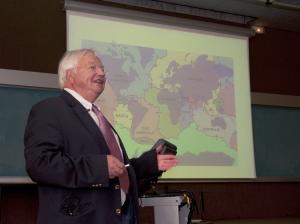Of plate tectonics and ripe camembert
30 Sep 2011
-
Robert Arnoux
In last Monday's Inside ITER seminar, Le Pichon gave a detailed and fascinating description of the tectonic dynamics at work off the coast of Japan and in Provence.
In 1968, French geophysicist Xavier Le Pichon proposed the model that brought the final acceptance by the scientific community of plate tectonics.
The model described and explained the motions of the Earth's crust and upper mantle, thus giving precious clues on why earthquakes happen.
Known as "plate tectonics", this theory is now universally recognized. It cannot anticipate when a seismic event will occur; it can, however, predict where the tensions at the plate boundaries will trigger the formidable liberation of energy that cause earthquakes and tsunamis.
In last Monday's Inside ITER seminar entitled "Insights from plate tectonics about the Japan 11 March 2011 earthquake and the seismicity of the Durance River Fault in Provence," Le Pichon gave a detailed and fascinating description of the tectonic dynamics at work in both regions.
Off the coast of Japan, four tectonic plates interact. The North American, the Philippine, the Pacific and the Eurasian plates either push against one another, or slide under the other in a movement called "subduction" that is responsible for the strong seismic activity in that area.
In Provence where Cadarache and ITER are located, seismic activity is "moderate," said Le Pichon. What causes the few "modest earthquakes" that have been recorded throughout history is not, as was generally admitted, the pressure exerted by the African plate against the Eurasian one.
"The culprit," Le Pichon stressed during the seminar, "is not Africa because the motion does not come from the south. The culprit, as geodesic measurements clearly indicate, is the collapse of the Alps, which are slowly spreading like a ripe camembert."
As the ripe camembert "glides downslope to the south" at the speed of 1/10th of a millimetre per year the pressure on the rigid substratum builds. Occasionally, every couple of hundred years, one of the "modest" Provençal earthquakes occurs like it did in Manosque in 1708 and in Lambesc, near Aix-en-Provence, in 1909—this should be compared to the much more significant subduction movements off the coast of Japan, which range from 5 to 8 centimetres per year.
A professor emeritus at the prestigious College de France, a member of the French Académie des sciences and an associate member of the US National Academy of Science, Le Pichon considers that, despite their cost, "good, modern seismic profiles are necessary to better define the seismic risk."


